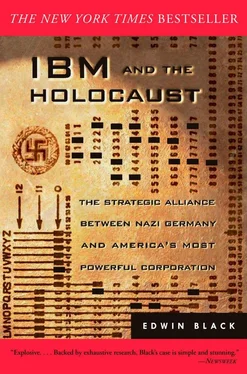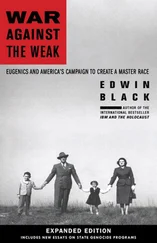“The physician examines the human body and determines whether… all organs are working to the benefit of the entire organism,” asserted Heidinger to a crowd of Nazi officials. “We [Dehomag] are very much like the physician, in that we dissect, cell by cell, the German cultural body. We report every individual characteristic… on a little card. These are not dead cards, quite to the contrary, they prove later on that they come to life when the cards are sorted at a rate of 25,000 per hour according to certain characteristics. These characteristics are grouped like the organs of our cultural body, and they will be calculated and determined with the help of our tabulating machine. 119
“We are proud that we may assist in such task, a task that provides our nation’s Physician [Adolf Hitler] with the material he needs for his examinations. Our Physician can then determine whether the calculated values are in harmony with the health of our people. It also means that if such is not the case, our Physician can take corrective procedures to correct the sick circumstances…. Our characteristics are deeply rooted in our race. Therefore, we must cherish them like a holy shrine which we will—and must—keep pure. We have the deepest trust in our Physician and will follow his instructions in blind faith, because we know that he will lead our people to a great future. Hail to our German people and der Führer !” 120
Most of Heidinger’s speech, along with a list of the invited Nazi Party officials, was rushed to Manhattan and immediately translated for Watson. The IBM Leader cabled Heidinger a prompt note of congratulations for a job well done and sentiments well expressed. 121
It was right about this time that Watson decided to engrave the five steps leading up to the door of the IBM School in Endicott, New York, with five of his favorite words. This school was the place where Watson would train his valued disciples in the art of sales, engineering, and technical support. Those five uppermost steps, steps that each man ascended before entering the front door, were engraved with the following words:
READ
LISTEN
DISCUSS
OBSERVE
The fifth and uppermost step was chiseled with the heralded theme of the company. It said THINK. 122
The word THINK was everywhere.
III. IDENTIFYING THE JEWS
THEY WERE SINGING TO THEIR LEADER.
Arms locked, swaying in song, male voices rising in adulation and expectation, they crooned their praises with worship-ful enthusiasm. Clicking beer steins in self-congratulation, reassured by their vision of things to come, Storm Troopers everywhere sang the “ Horst Wessel Song” as a Nazi testament and a prophecy both.
This is the final
Bugle call to arms.
Already we are set
Prepared to fight.
Soon Hitler’s flags will wave
Over every single street
Enslavement ends
When soon we set things right!
Whether in beer halls, sports fields, or just swaggering down the streets, Brown Shirts throughout the Third Reich joyously chanted their most popular anthem. With good reason. For the Sturm Abteilung (SA), or Storm Troopers, the ascent of Adolf Hitler was deliverance from the destitution and disconsolation of lives long disenfranchised by personal circumstance or character. But they needed a scapegoat. They blamed the Jews—for everything. Jews had conspired to create the Depression, to enslave the German race, to control society, and to pollute Aryan blood. And now the followers of Hitler would exact their bizarre brand of justice and revenge.
More precisely, the Nazis planned to uproot the alien Jews from their prized positions within German commerce and culture. The angry young men of the SA, many of them dregs within German society, believed they would soon step into all the economic and professional positions held by their Jewish neighbors. Through unending racial statutes ousting Jews from professional and commercial life, relentless purges and persecution, unyielding programs of asset confiscation, systematic imprisonment and outright expulsion, the SA would usurp the Jewish niche. Nazis would assume Jewish jobs, expropriate Jewish companies, seize Jewish property, and in all other ways banish Jews from every visible facet of society. Once the Nazis finished with the Jews of Germany, they would extend their race war first to the Greater Reich in Europe they envisioned, and ultimately to the entire Continent. 1
But Jewish life could only be extinguished if the Nazis could identify the Jews. Just which of Germany’s 60 million citizens were Jewish? And just what was the definition of “Jewish”? Germans Jews were among the most assimilated of any in Europe.
Nazi mythology accused Jews of being an alien factor in German society. But in truth, Jews had lived in Germany since the fourth century. As elsewhere in Europe during the Middle Ages, what German Jews could do and say, even their physical dress, was oppressively regulated. Waves of persecution were frequent. Worse, anti-Jewish mobs often organized hangings and immolation at the stake. Even when left alone, German Jews could exist only in segregated ghettos subject to a long list of prohibitions. 2
The pressure to escape Germany’s medieval persecution created a very special kind of European Jew, one who subordinated his Jewish identity to the larger Christian society around him. Assimilation became a desirable anti-dote, especially among Jewish intellectuals during the Age of Enlightenment. When Napoleon conquered part of Germany in the early nineteenth century, he granted Jews emancipation. But after Napoleon was defeated, the harsh German status quo ante was restored. The taste of freedom, however, led affluent and intellectual Jewish classes to assimilate en masse. Philosophically, assimilationists no longer considered themselves Jews living in Germany. Instead, they saw themselves as Germans who, by accident of birth, were of Jewish ancestry. 3
Many succumbed to the German pressure to convert to Christianity. German Jewry lost to apostasy many of its best commercial, political, and intellectual leaders. A far greater number were convinced that Jewish ethnic identity should be denied, but nonetheless saw quintessential value in the tenets of Moses. These German Jews developed a religious movement that was the forerunner of Reform Judaism. Yet, even many of this group ultimately converted to Christianity. 4
Between 1869 and 1871, Germany granted Jews emancipation from many, but not all, civic, commercial, and political restrictions. Germany’s Jews seized the chance to become equals. They changed their surnames, adopted greater religious laxity through Reform Judaism, and frequently married non-Jews, raising their children as Christians. Outright conversion became common. Many of Jewish ancestry did not even know it—or care. 5
In fact, of approximately 550,000 Jews in Germany who were emancipated in 1871, roughly 60,000 were by 1930 either apostates, children raised without Jewish identity by a mixed marriage, or Jews who had simply drifted away. Even those consciously remaining within organized Jewish “communities” neglected their remnant Jewish identity. The Jews of twentieth-century Germany, like their Christian neighbors, embraced national identity far more than religious identity. In the minds of German Jews, they were “101 percent” German, first and foremost. 6
But the Reich believed otherwise. The Jewish nemesis was not one of religious practice, but of bloodline. Nazis were determined to somehow identify those of Jewish descent, and destroy them.
* * *
IDENTIFYING THEJews in Germany would be an uphill technologic challenge that would take years of increasingly honed counting programs and registration campaigns. From the moment Hitler was appointed Chancellor, fear gripped the entire Jewish community. No Jew wanted to step forward and identify himself as Jewish, and therefore become targeted for persecution. Many doubted they even possessed enough Jewish parentage to be included in the despised group. Indeed, not a few frightened Jews tried to join the denunciations of the Jewish community to emphasize their loyal German national character. 7But that did not help them.
Читать дальше












